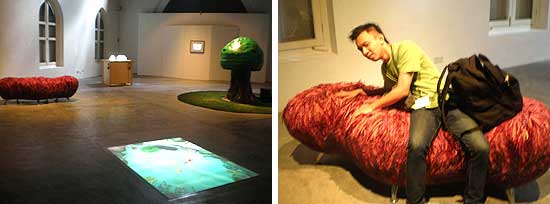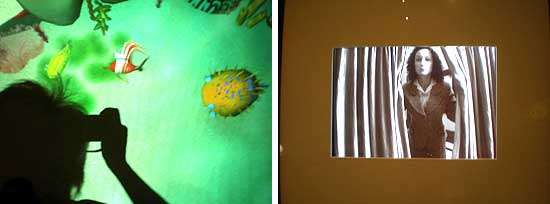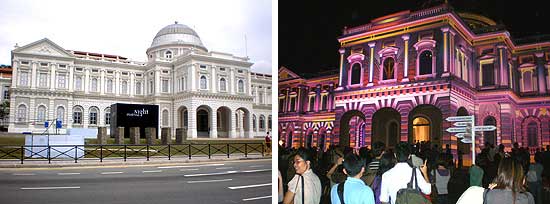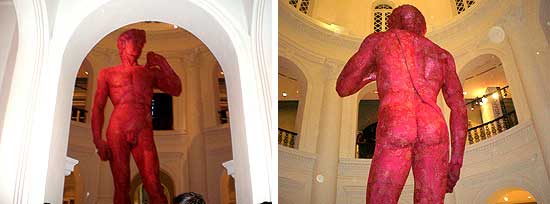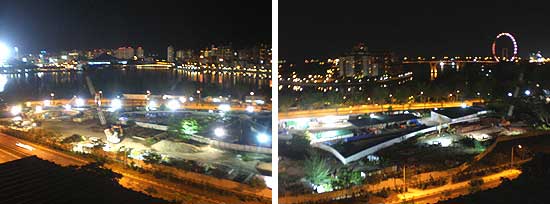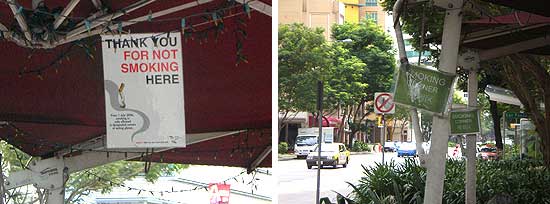ISEA 2008
Singapore
International Symposium on Electronic Arts
By Mina Cheon
ISEA 2008, International Symposium on Electronic Arts, in Singapore is pure elegance.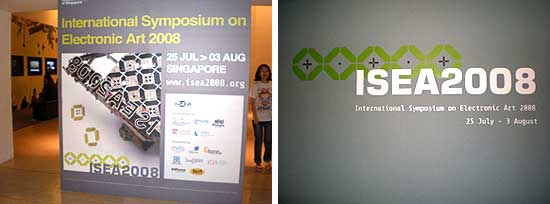
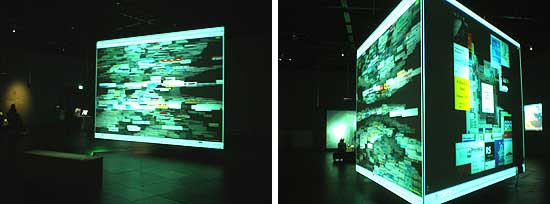 “Exodus” by Metahaven
“Exodus” by MetahavenThe monumental installation “Exodus” by Metahaven from Amsterdam and Brussels, hosted by Lab for Media Research, display the output of a programmed visual search engine. It is written that it is a “research engine” that uses “algorithms and visual strategies for searching the Internet, revealing the structural properties of web content and its inherent distribution of influence.” This project comments on the information hierarchy presented by search engine systems, which information is given priority and which is left behind, and questions how that is determined. http://www.metahaven.net 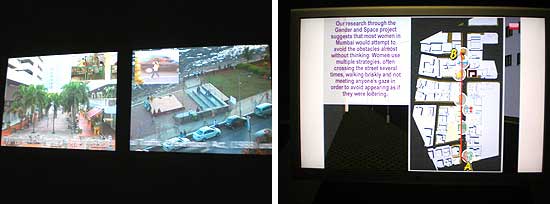 Loitering” by artists Shilpa Phadke, Shilpa Ranade and Sameera Khan
Loitering” by artists Shilpa Phadke, Shilpa Ranade and Sameera Khan
“Gendered Strategies for Loitering” by artists Shilpa Phadke, Shilpa Ranade, and Sameera Khan from India, and in collaboration with University Scholars Programme Cyberarts Studio, traces women loiterers in Mumbai, India. Although it is common for men to loiter and just hang around, the project looks at the stereotype produced when women do it. The differentiation of social connotation when women are loitering demarcates public spaces as gendered spaces. Hence, the piece examines the gendering of space through the conceptual occupancy of loiter, which seems to be an acceptable male’s space. It is written that the “research through Gender and Space project suggests that most women in Mumbai would attempt to avoid the obstacles almost without thinking. Women use multiple strategies, often crossing the street several times, walking briskly and not meeting anyone’s gaze in order to avoid appearing as if they are loitering.” http://www.genderandspace.org 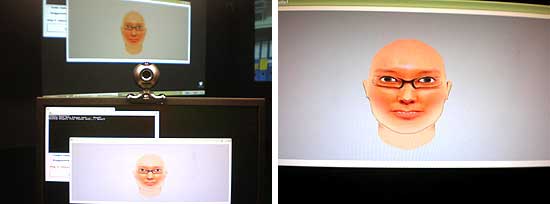 “Smile J, Wear It Like a Costume” by Momoyo Torimitsu
“Smile J, Wear It Like a Costume” by Momoyo Torimitsu“Smile J, Wear It Like a Costume” by Momoyo Torimitsu from Japan, and in collaboration with NUS Face Group, is an interface that captures the interactor’s face in order to re-make the snap shot of the face with a selectable palette of smiles. The many roles of smiles varies as much as the kind of smiles there are that people ‘put on’ daily. The piece reinforces the artificiality that comes out with the naturalness of smiling as well as how patterns can emerge through the staging of smiles, where facial gestures are the main interface for social communications. http://momoyotorimitsu.com 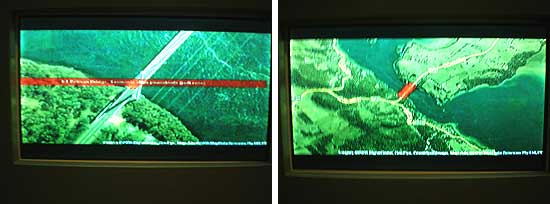 “The Global Bridge Symphony” by artist Jodi Rose
“The Global Bridge Symphony” by artist Jodi Rose
“The Global Bridge Symphony” by artist Jodi Rose from Australia, and collaborating with Ambient Intelligence lab and Communications Laboratory, display large columns dispersed throughout the gallery that show abstract to representational videos intersecting ideas, visuals, sounds, and text pertaining to the concept of the bridge. Hence, creating a symphony of bridges from all around the world in the exhibition space. One of the texts reads, “The most beautiful bridge in the world. So pure, so resolute, so regular that here, finally, steel architecture seems to laugh. – Le Corbusier.” And, another one states
that “The bridge is a location. It allows a space into which earth and heaven, divinities and mortals are admitted. The space allowed by the bridge contains many places variously near or far from the bridge. – Martin Heidegger.” http://www.singingbridges.net 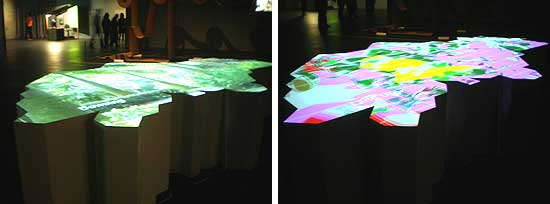 “Sourcing Water” by Shiho Fukuhata
“Sourcing Water” by Shiho Fukuhata“Sourcing Water” by Shiho Fukuhata from Japan, Georg Tremmel from Austria, with Yousuke Nagao, and hosted by Singapore-Delft Water Alliance (SDWA) deals with eco-resource concerns of water in Singapore. Since most of Singapore’s water is imported from Malaysia, the artists use dowsing rods with GPS and motion sensors to track water sources in Singapore and create visuals and maps of these potential water hotspots. http://bcl.biopresence.org/srch20 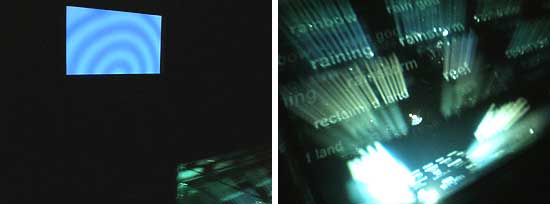 “The Water Book: An Encyclopedia of Water” by Clea T. Waite
“The Water Book: An Encyclopedia of Water” by Clea T. Waite“The Water Book: An Encyclopedia of Water” by Clea T. Waite from US and Germany, and in collaboration with Singapore-Deft Water Alliance (SDWA), creates another water piece that is interactive using text, water, touch sensor, and light. By interacting and touching the water, the viewers can experience sound and images related to the subject of water. The piece states how water” is the key component in the environmental transformation that the planet is now experiencing. It is the most powerful symbol of flow, purity and survival, and plays essential roles in our daily life as well as global geopolitics.” http://clea-t.de 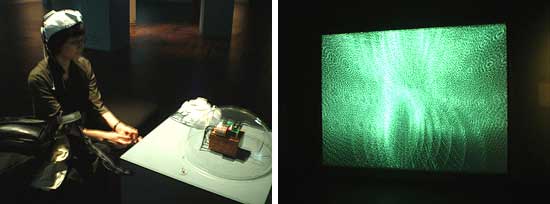 “Aurora Consurgens” by Horia Cosmin Smoila and Marie Christine Driesen
“Aurora Consurgens” by Horia Cosmin Smoila and Marie Christine Driesen“Aurora Consurgens” by Horia Cosmin Smoila from Romania and Marie Christine Driesen from France, and in collaboration with Mixed Reality Lab, creates visualization of brain waves. It is written, “The installation offers an alternative way to render the different states of consciousness through the exploration of cognitive conglomerates. The observer is invited to explore a paradoxical place of creation where the brain waves articulate the evocations of archetypal constructions…” http://ghostlab.org
Out of the partner exhibitions, Experimenta Play ++: Art for the 21st Century at the Sculpture Garden is a traveling exhibition, which has come to Singapore. It is an exhibition of Australian media art, curated by Caroline Farmer and Liz Hughes. It is unlike any of the other exhibitions with its playful and fantastical Alice in Wonderland appearance and interaction. http://www.experimenta.org A very warm reception by “Zizi the Affectionate Couch” (right) by artists Stephen Barrass, Linda Davy, Robert Davy & Kerry Richens. The piece is a furry couch that purrs and vibrates as one sits and cuddles it. The piece combines domesticated pets with comfort furniture as one assemblage.
“Immersion” (left) by Angela Barnett, Andrew Buchanan, Darren Ballingall, Chris MacKellar and Christian Rubino is a floor projection piece that creates 3D animated sea creatures by the interaction of one’s shadows. “The Shy Picture” (right) by Narinda Reeders and David MacLeod comprises of a small monitor on a large white wall where people in the video react based on the viewer’s proximity. The characters literally run away or shut the curtains in front of the interactor. The piece calls attention to the relationship between the viewer, camera, screen, and characters in the most delightful and charming way while intrinsically commenting on filmic issues of voyeurism and exposure.
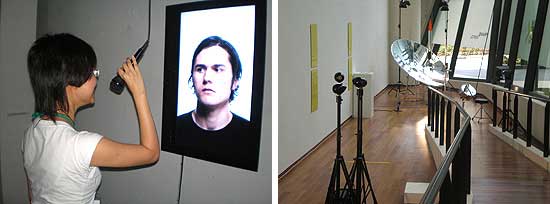
“Listening Heads” by Kentaro Yamada (left) allows interactors to speak into a microphone which then allows the faces on the screen to react differently according to the voices. This piece is eerie as the faces gestures real listening. This piece is in the exhibition Cloudland: Digital Art from Aotearoa New Zealand which is on view at The Substation. http://www.aotearoadigitalarts.org.nz The Lucid Fields exhibition which displays media artworks by Swiss Artists-in-Labs at the Lasalle college of Arts shows many works that contributed to the debates of scientific research. Out of them, “The Rocket for the Rest of Us” by Roman Keller is the “actual rocket…[that] results from collaboration with scientists in the lab on alternative future energies.” From the series of panels that are held at the Singapore Management University, Nanyang Technological University, as well as other spaces, “Borders Reckonings: Border Crossings” holds a lively discussion about the concept of borders: from borders that surround Austria, the North/South Korean border, Urban borders, to scattered borders which are everywhere; “Intelligent Architecture” panel presents alternative models of architecture thinking and Paul Thomas speaks about the transsubstantiation possibilities in architecture that can come with transgression devices such as in a non-perspectival method of mapping through GPS systems as a new mode of recording time and space.
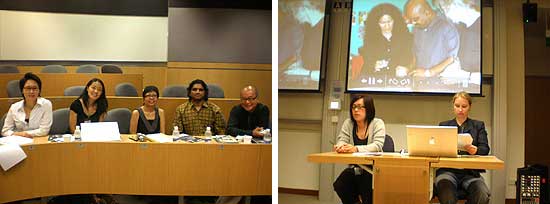
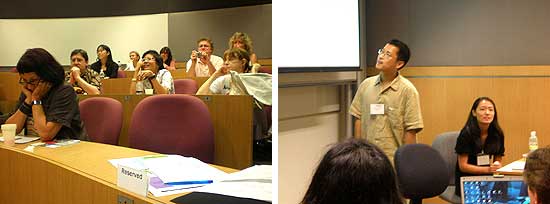
“Passing and Peril on the Information Super Highway”
(top left) chaired by Kóan Jeff Baysa deals with intense issues of racism, nationalism, and geo-politics in cyberculture. The panelists include: Mina Cheon, who presents Kenkanryu (The Hate Korean Wave) in Japanese Manga; Jiayi Young, who shows cyberculture in China and political blockage / censoring; Judy Sibayan, who publishes the most radical and subversive critical arts journal on-line Ctrl+P, and Roopesh Sitharan who examines bloggers gone politicians in Malaysia. “Locating Cyberfeminism” panel chaired by Irina Aristarkhova (top right) is a forum that voices the possibilities of the other in cyberfeminism and includes herself and Margaret Tan dialoguing about their experience with SubRosa in Singapore in 2003; Mara Tralla who looks at cyberfeminism from Estonia; Boryana Rossa, who sends a presentation from Bulgaria looking at the stereotype of women & machine that is found in popular cultures; and Mina Cheon who presents a paper on three Korean female artists while tracing the issues of displacement, performativity, and subjectivity in cyberfeminist discourse. Lastly, Artist & scientist team Jiayi Young and Shih-Wen Young, in the panel of arts & science intersection, shows their collaboration “Regular Irregularity (RI)” where through chaos theory, the minute change affects the outcome of the entire system. They show their project “Baby Nuna” where they utilize sounds from a nuclear powerplant in France to create a moving image representation as well as their recent piece on converting Chinese calligraphy and construction notes into scribbles of lines. This piece is being exhibited at the Beijing Chinese Biennale 2008, opening August 2nd and it is the Chinese Character Biennale at the KU Art Center, curated by Kóan Jeff Baysa.
ISEA 2008 is in Singapore from 25 July – 3 August.
Five Main Themes of the Symposium: Locating Media, Reality Jam, Wiki Wiki, Ludic Interfaces, and Border Transmission
Includes: Main Juried Exhibition, Partner Exhibitions, Keynotes, Invited Forums, Panels, Workshops, Media Presentations, Performances, and other events.
Website: http://www.isea2008singapore.org/
And Singapore Now:Event is “Night Festival,” National Museum of Singapore’s day appearance changes with color projection at night.
“Surrounding David” by Titarubi is at the lobby rotunda of the National Museum of Singapore. It is 8.5 meters tall.
Whose got the best view in Singapore? Korean journalist Yoolim Lee of Bloomberg, view seen from Golden Mile Tower.
Thank you for not smoking here. Smoking Area. These are examples of “scattered borders.” Singapore has the most prohibition notices one can ever see in a country. The country is unique for its commercial openness that comes with legal behavioral regulations.








